Detailed Analysis of Leadership Challenges in Learning Organizations
VerifiedAdded on 2022/12/18
|8
|1984
|34
Essay
AI Summary
This essay delves into the multifaceted challenges of leadership within learning organizations. It begins by defining a learning organization and highlighting the critical role of leadership in fostering its development. The essay then explores various leadership challenges, including change management, ensuring employee mental health, developing effective communication skills, handling conflicts, and promoting employee motivation. It examines the importance of leaders understanding and addressing the perspectives of their followers, fostering employee growth, and implementing changes effectively. The essay also discusses the significance of mental health programs, conflict resolution strategies, and strategies to engage learners and quantify training effectiveness. The author provides insights and recommendations for overcoming these challenges, emphasizing the need for leaders to demonstrate cultural competence, create formal conflict resolution processes, and implement methods for assessing the impact of training programs. The essay is supported by academic sources and provides a comprehensive analysis of the leadership challenges in a learning organization.
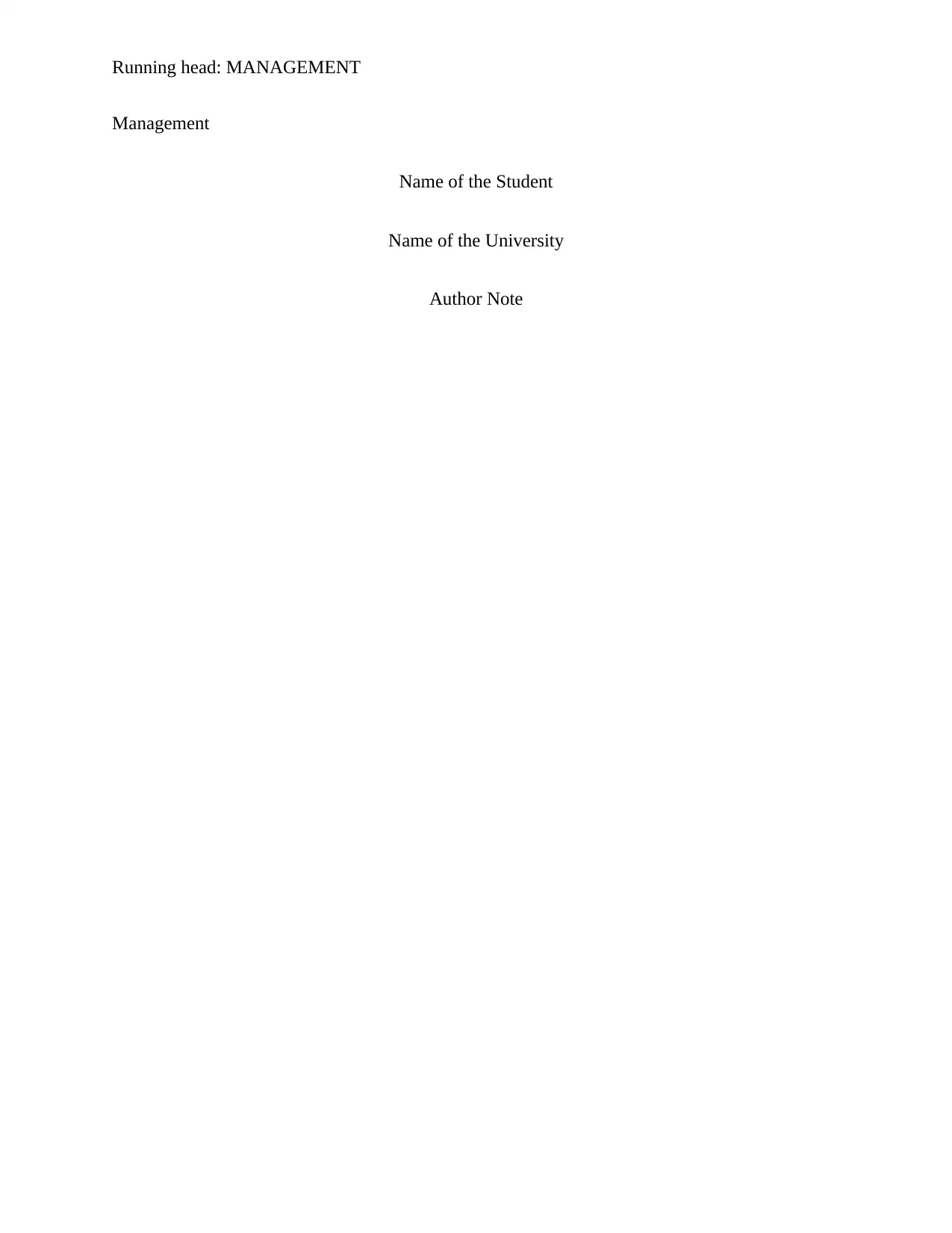
Running head: MANAGEMENT
Management
Name of the Student
Name of the University
Author Note
Management
Name of the Student
Name of the University
Author Note
Paraphrase This Document
Need a fresh take? Get an instant paraphrase of this document with our AI Paraphraser
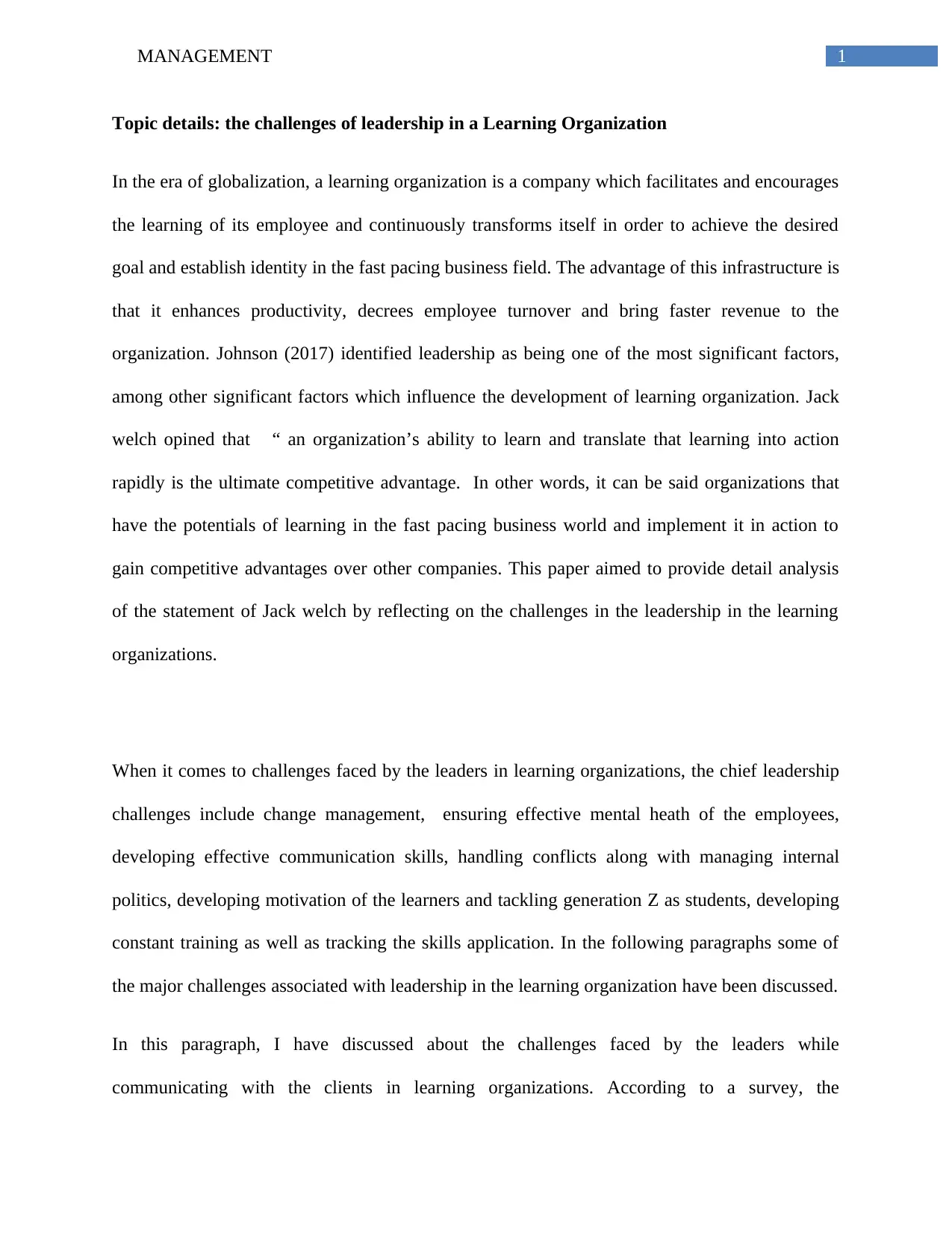
1MANAGEMENT
Topic details: the challenges of leadership in a Learning Organization
In the era of globalization, a learning organization is a company which facilitates and encourages
the learning of its employee and continuously transforms itself in order to achieve the desired
goal and establish identity in the fast pacing business field. The advantage of this infrastructure is
that it enhances productivity, decrees employee turnover and bring faster revenue to the
organization. Johnson (2017) identified leadership as being one of the most significant factors,
among other significant factors which influence the development of learning organization. Jack
welch opined that “ an organization’s ability to learn and translate that learning into action
rapidly is the ultimate competitive advantage. In other words, it can be said organizations that
have the potentials of learning in the fast pacing business world and implement it in action to
gain competitive advantages over other companies. This paper aimed to provide detail analysis
of the statement of Jack welch by reflecting on the challenges in the leadership in the learning
organizations.
When it comes to challenges faced by the leaders in learning organizations, the chief leadership
challenges include change management, ensuring effective mental heath of the employees,
developing effective communication skills, handling conflicts along with managing internal
politics, developing motivation of the learners and tackling generation Z as students, developing
constant training as well as tracking the skills application. In the following paragraphs some of
the major challenges associated with leadership in the learning organization have been discussed.
In this paragraph, I have discussed about the challenges faced by the leaders while
communicating with the clients in learning organizations. According to a survey, the
Topic details: the challenges of leadership in a Learning Organization
In the era of globalization, a learning organization is a company which facilitates and encourages
the learning of its employee and continuously transforms itself in order to achieve the desired
goal and establish identity in the fast pacing business field. The advantage of this infrastructure is
that it enhances productivity, decrees employee turnover and bring faster revenue to the
organization. Johnson (2017) identified leadership as being one of the most significant factors,
among other significant factors which influence the development of learning organization. Jack
welch opined that “ an organization’s ability to learn and translate that learning into action
rapidly is the ultimate competitive advantage. In other words, it can be said organizations that
have the potentials of learning in the fast pacing business world and implement it in action to
gain competitive advantages over other companies. This paper aimed to provide detail analysis
of the statement of Jack welch by reflecting on the challenges in the leadership in the learning
organizations.
When it comes to challenges faced by the leaders in learning organizations, the chief leadership
challenges include change management, ensuring effective mental heath of the employees,
developing effective communication skills, handling conflicts along with managing internal
politics, developing motivation of the learners and tackling generation Z as students, developing
constant training as well as tracking the skills application. In the following paragraphs some of
the major challenges associated with leadership in the learning organization have been discussed.
In this paragraph, I have discussed about the challenges faced by the leaders while
communicating with the clients in learning organizations. According to a survey, the
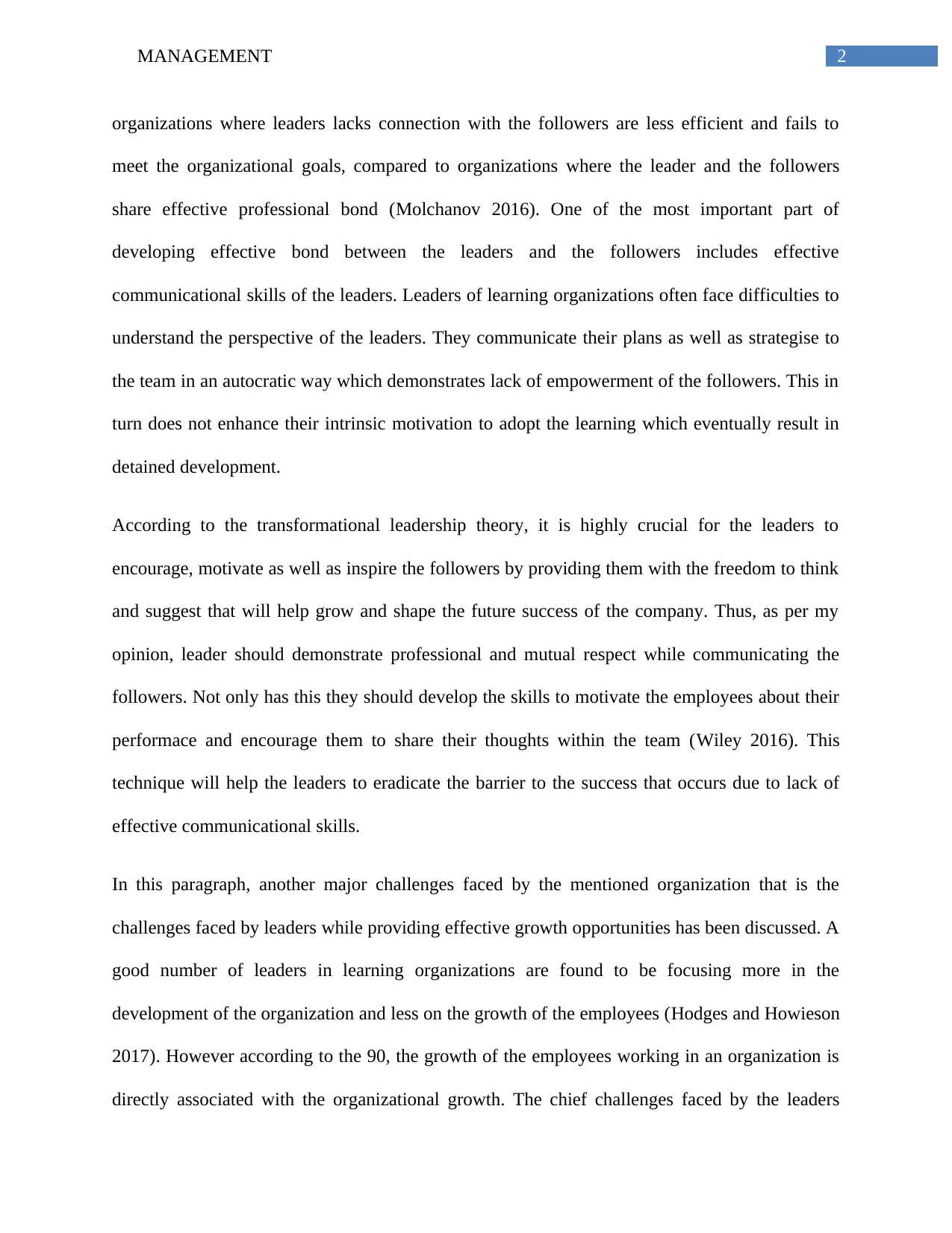
2MANAGEMENT
organizations where leaders lacks connection with the followers are less efficient and fails to
meet the organizational goals, compared to organizations where the leader and the followers
share effective professional bond (Molchanov 2016). One of the most important part of
developing effective bond between the leaders and the followers includes effective
communicational skills of the leaders. Leaders of learning organizations often face difficulties to
understand the perspective of the leaders. They communicate their plans as well as strategise to
the team in an autocratic way which demonstrates lack of empowerment of the followers. This in
turn does not enhance their intrinsic motivation to adopt the learning which eventually result in
detained development.
According to the transformational leadership theory, it is highly crucial for the leaders to
encourage, motivate as well as inspire the followers by providing them with the freedom to think
and suggest that will help grow and shape the future success of the company. Thus, as per my
opinion, leader should demonstrate professional and mutual respect while communicating the
followers. Not only has this they should develop the skills to motivate the employees about their
performace and encourage them to share their thoughts within the team (Wiley 2016). This
technique will help the leaders to eradicate the barrier to the success that occurs due to lack of
effective communicational skills.
In this paragraph, another major challenges faced by the mentioned organization that is the
challenges faced by leaders while providing effective growth opportunities has been discussed. A
good number of leaders in learning organizations are found to be focusing more in the
development of the organization and less on the growth of the employees (Hodges and Howieson
2017). However according to the 90, the growth of the employees working in an organization is
directly associated with the organizational growth. The chief challenges faced by the leaders
organizations where leaders lacks connection with the followers are less efficient and fails to
meet the organizational goals, compared to organizations where the leader and the followers
share effective professional bond (Molchanov 2016). One of the most important part of
developing effective bond between the leaders and the followers includes effective
communicational skills of the leaders. Leaders of learning organizations often face difficulties to
understand the perspective of the leaders. They communicate their plans as well as strategise to
the team in an autocratic way which demonstrates lack of empowerment of the followers. This in
turn does not enhance their intrinsic motivation to adopt the learning which eventually result in
detained development.
According to the transformational leadership theory, it is highly crucial for the leaders to
encourage, motivate as well as inspire the followers by providing them with the freedom to think
and suggest that will help grow and shape the future success of the company. Thus, as per my
opinion, leader should demonstrate professional and mutual respect while communicating the
followers. Not only has this they should develop the skills to motivate the employees about their
performace and encourage them to share their thoughts within the team (Wiley 2016). This
technique will help the leaders to eradicate the barrier to the success that occurs due to lack of
effective communicational skills.
In this paragraph, another major challenges faced by the mentioned organization that is the
challenges faced by leaders while providing effective growth opportunities has been discussed. A
good number of leaders in learning organizations are found to be focusing more in the
development of the organization and less on the growth of the employees (Hodges and Howieson
2017). However according to the 90, the growth of the employees working in an organization is
directly associated with the organizational growth. The chief challenges faced by the leaders
⊘ This is a preview!⊘
Do you want full access?
Subscribe today to unlock all pages.

Trusted by 1+ million students worldwide
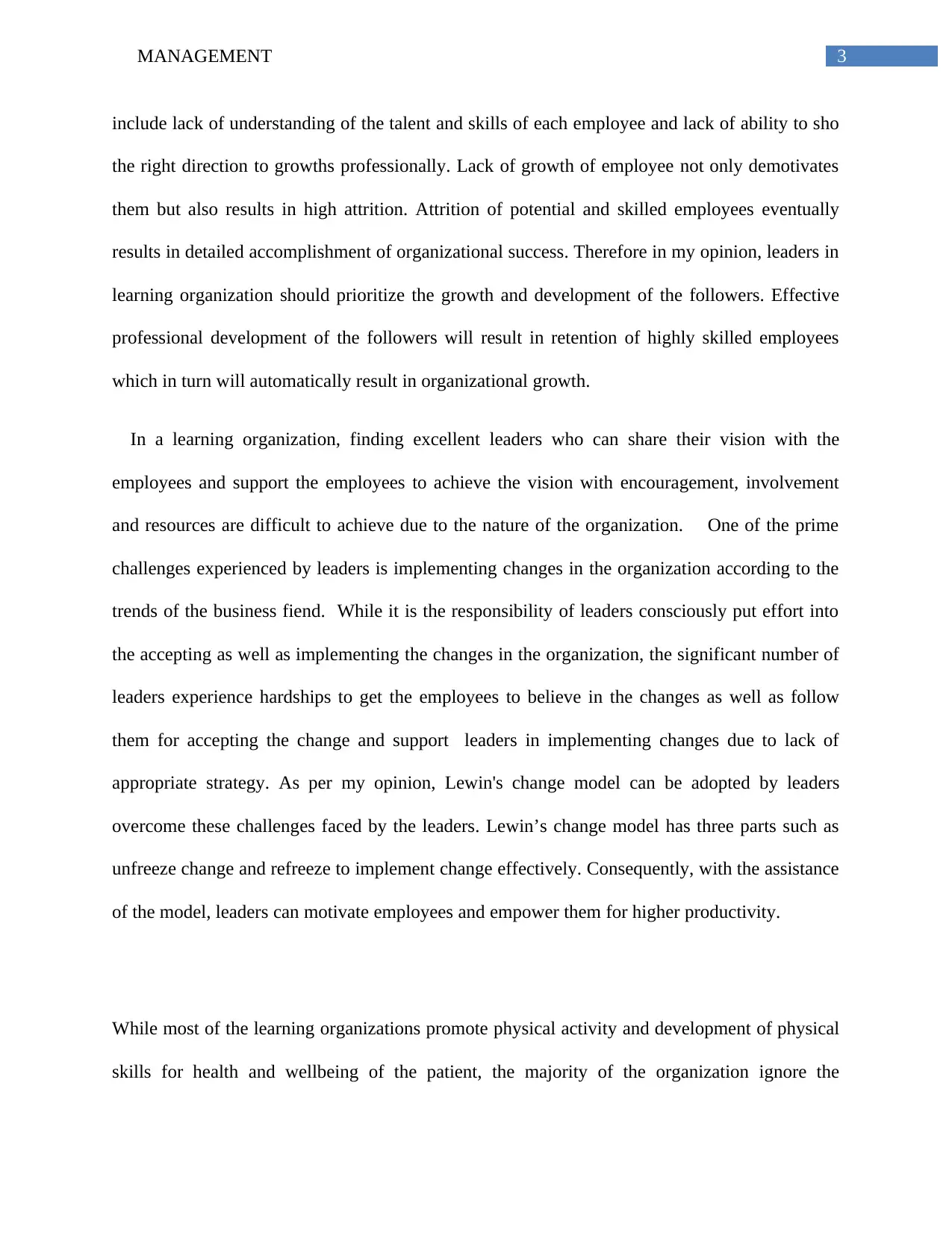
3MANAGEMENT
include lack of understanding of the talent and skills of each employee and lack of ability to sho
the right direction to growths professionally. Lack of growth of employee not only demotivates
them but also results in high attrition. Attrition of potential and skilled employees eventually
results in detailed accomplishment of organizational success. Therefore in my opinion, leaders in
learning organization should prioritize the growth and development of the followers. Effective
professional development of the followers will result in retention of highly skilled employees
which in turn will automatically result in organizational growth.
In a learning organization, finding excellent leaders who can share their vision with the
employees and support the employees to achieve the vision with encouragement, involvement
and resources are difficult to achieve due to the nature of the organization. One of the prime
challenges experienced by leaders is implementing changes in the organization according to the
trends of the business fiend. While it is the responsibility of leaders consciously put effort into
the accepting as well as implementing the changes in the organization, the significant number of
leaders experience hardships to get the employees to believe in the changes as well as follow
them for accepting the change and support leaders in implementing changes due to lack of
appropriate strategy. As per my opinion, Lewin's change model can be adopted by leaders
overcome these challenges faced by the leaders. Lewin’s change model has three parts such as
unfreeze change and refreeze to implement change effectively. Consequently, with the assistance
of the model, leaders can motivate employees and empower them for higher productivity.
While most of the learning organizations promote physical activity and development of physical
skills for health and wellbeing of the patient, the majority of the organization ignore the
include lack of understanding of the talent and skills of each employee and lack of ability to sho
the right direction to growths professionally. Lack of growth of employee not only demotivates
them but also results in high attrition. Attrition of potential and skilled employees eventually
results in detailed accomplishment of organizational success. Therefore in my opinion, leaders in
learning organization should prioritize the growth and development of the followers. Effective
professional development of the followers will result in retention of highly skilled employees
which in turn will automatically result in organizational growth.
In a learning organization, finding excellent leaders who can share their vision with the
employees and support the employees to achieve the vision with encouragement, involvement
and resources are difficult to achieve due to the nature of the organization. One of the prime
challenges experienced by leaders is implementing changes in the organization according to the
trends of the business fiend. While it is the responsibility of leaders consciously put effort into
the accepting as well as implementing the changes in the organization, the significant number of
leaders experience hardships to get the employees to believe in the changes as well as follow
them for accepting the change and support leaders in implementing changes due to lack of
appropriate strategy. As per my opinion, Lewin's change model can be adopted by leaders
overcome these challenges faced by the leaders. Lewin’s change model has three parts such as
unfreeze change and refreeze to implement change effectively. Consequently, with the assistance
of the model, leaders can motivate employees and empower them for higher productivity.
While most of the learning organizations promote physical activity and development of physical
skills for health and wellbeing of the patient, the majority of the organization ignore the
Paraphrase This Document
Need a fresh take? Get an instant paraphrase of this document with our AI Paraphraser
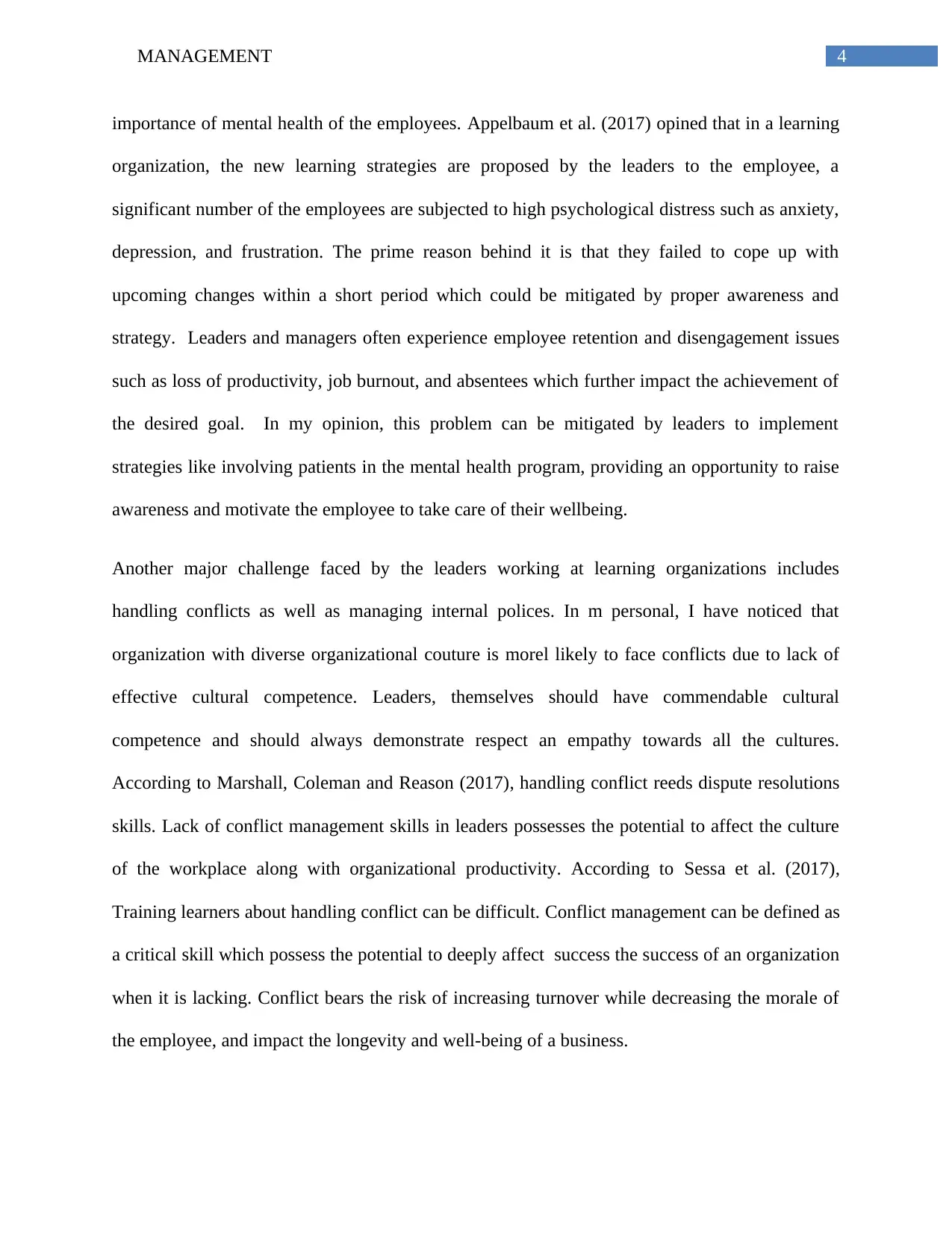
4MANAGEMENT
importance of mental health of the employees. Appelbaum et al. (2017) opined that in a learning
organization, the new learning strategies are proposed by the leaders to the employee, a
significant number of the employees are subjected to high psychological distress such as anxiety,
depression, and frustration. The prime reason behind it is that they failed to cope up with
upcoming changes within a short period which could be mitigated by proper awareness and
strategy. Leaders and managers often experience employee retention and disengagement issues
such as loss of productivity, job burnout, and absentees which further impact the achievement of
the desired goal. In my opinion, this problem can be mitigated by leaders to implement
strategies like involving patients in the mental health program, providing an opportunity to raise
awareness and motivate the employee to take care of their wellbeing.
Another major challenge faced by the leaders working at learning organizations includes
handling conflicts as well as managing internal polices. In m personal, I have noticed that
organization with diverse organizational couture is morel likely to face conflicts due to lack of
effective cultural competence. Leaders, themselves should have commendable cultural
competence and should always demonstrate respect an empathy towards all the cultures.
According to Marshall, Coleman and Reason (2017), handling conflict reeds dispute resolutions
skills. Lack of conflict management skills in leaders possesses the potential to affect the culture
of the workplace along with organizational productivity. According to Sessa et al. (2017),
Training learners about handling conflict can be difficult. Conflict management can be defined as
a critical skill which possess the potential to deeply affect success the success of an organization
when it is lacking. Conflict bears the risk of increasing turnover while decreasing the morale of
the employee, and impact the longevity and well-being of a business.
importance of mental health of the employees. Appelbaum et al. (2017) opined that in a learning
organization, the new learning strategies are proposed by the leaders to the employee, a
significant number of the employees are subjected to high psychological distress such as anxiety,
depression, and frustration. The prime reason behind it is that they failed to cope up with
upcoming changes within a short period which could be mitigated by proper awareness and
strategy. Leaders and managers often experience employee retention and disengagement issues
such as loss of productivity, job burnout, and absentees which further impact the achievement of
the desired goal. In my opinion, this problem can be mitigated by leaders to implement
strategies like involving patients in the mental health program, providing an opportunity to raise
awareness and motivate the employee to take care of their wellbeing.
Another major challenge faced by the leaders working at learning organizations includes
handling conflicts as well as managing internal polices. In m personal, I have noticed that
organization with diverse organizational couture is morel likely to face conflicts due to lack of
effective cultural competence. Leaders, themselves should have commendable cultural
competence and should always demonstrate respect an empathy towards all the cultures.
According to Marshall, Coleman and Reason (2017), handling conflict reeds dispute resolutions
skills. Lack of conflict management skills in leaders possesses the potential to affect the culture
of the workplace along with organizational productivity. According to Sessa et al. (2017),
Training learners about handling conflict can be difficult. Conflict management can be defined as
a critical skill which possess the potential to deeply affect success the success of an organization
when it is lacking. Conflict bears the risk of increasing turnover while decreasing the morale of
the employee, and impact the longevity and well-being of a business.
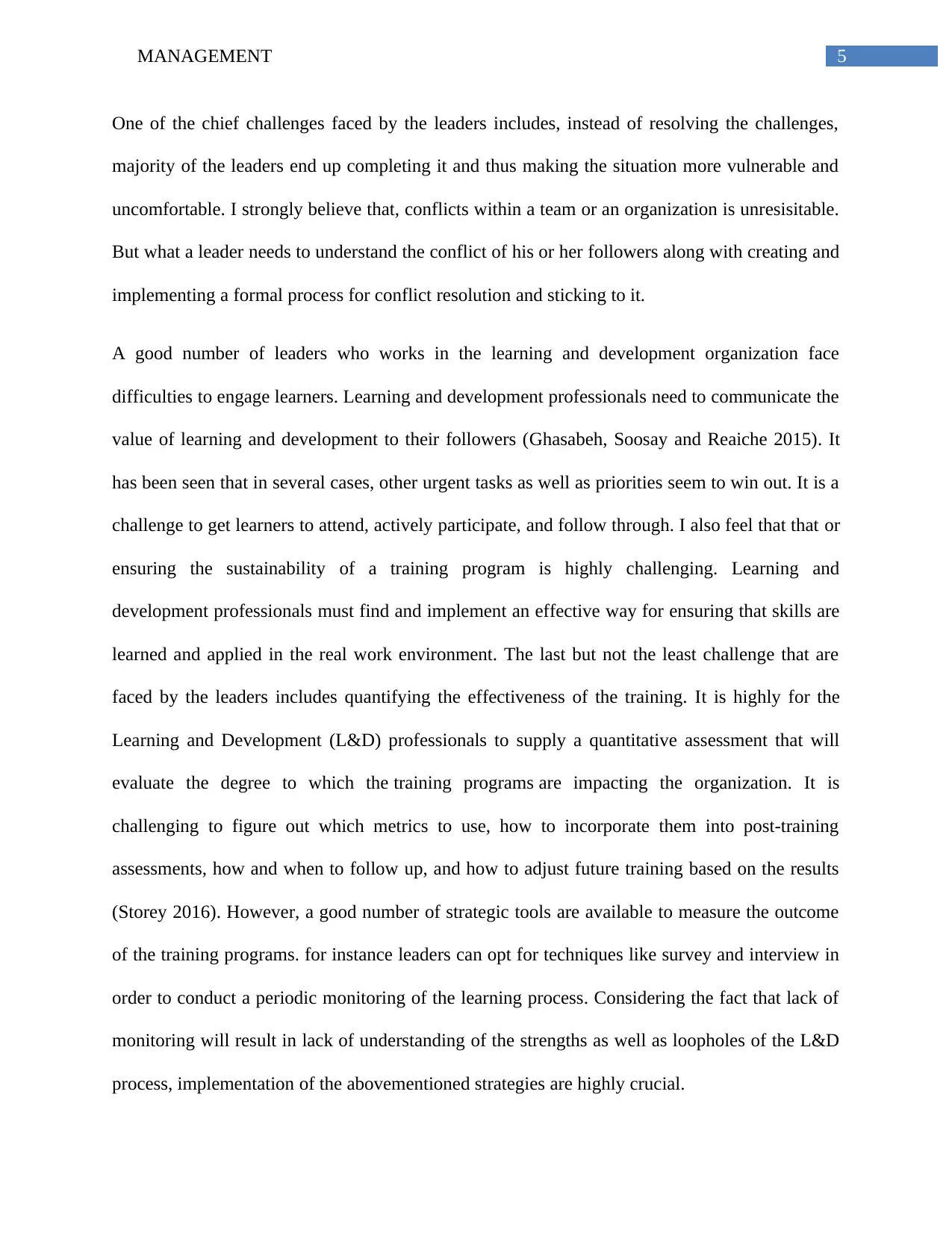
5MANAGEMENT
One of the chief challenges faced by the leaders includes, instead of resolving the challenges,
majority of the leaders end up completing it and thus making the situation more vulnerable and
uncomfortable. I strongly believe that, conflicts within a team or an organization is unresisitable.
But what a leader needs to understand the conflict of his or her followers along with creating and
implementing a formal process for conflict resolution and sticking to it.
A good number of leaders who works in the learning and development organization face
difficulties to engage learners. Learning and development professionals need to communicate the
value of learning and development to their followers (Ghasabeh, Soosay and Reaiche 2015). It
has been seen that in several cases, other urgent tasks as well as priorities seem to win out. It is a
challenge to get learners to attend, actively participate, and follow through. I also feel that that or
ensuring the sustainability of a training program is highly challenging. Learning and
development professionals must find and implement an effective way for ensuring that skills are
learned and applied in the real work environment. The last but not the least challenge that are
faced by the leaders includes quantifying the effectiveness of the training. It is highly for the
Learning and Development (L&D) professionals to supply a quantitative assessment that will
evaluate the degree to which the training programs are impacting the organization. It is
challenging to figure out which metrics to use, how to incorporate them into post-training
assessments, how and when to follow up, and how to adjust future training based on the results
(Storey 2016). However, a good number of strategic tools are available to measure the outcome
of the training programs. for instance leaders can opt for techniques like survey and interview in
order to conduct a periodic monitoring of the learning process. Considering the fact that lack of
monitoring will result in lack of understanding of the strengths as well as loopholes of the L&D
process, implementation of the abovementioned strategies are highly crucial.
One of the chief challenges faced by the leaders includes, instead of resolving the challenges,
majority of the leaders end up completing it and thus making the situation more vulnerable and
uncomfortable. I strongly believe that, conflicts within a team or an organization is unresisitable.
But what a leader needs to understand the conflict of his or her followers along with creating and
implementing a formal process for conflict resolution and sticking to it.
A good number of leaders who works in the learning and development organization face
difficulties to engage learners. Learning and development professionals need to communicate the
value of learning and development to their followers (Ghasabeh, Soosay and Reaiche 2015). It
has been seen that in several cases, other urgent tasks as well as priorities seem to win out. It is a
challenge to get learners to attend, actively participate, and follow through. I also feel that that or
ensuring the sustainability of a training program is highly challenging. Learning and
development professionals must find and implement an effective way for ensuring that skills are
learned and applied in the real work environment. The last but not the least challenge that are
faced by the leaders includes quantifying the effectiveness of the training. It is highly for the
Learning and Development (L&D) professionals to supply a quantitative assessment that will
evaluate the degree to which the training programs are impacting the organization. It is
challenging to figure out which metrics to use, how to incorporate them into post-training
assessments, how and when to follow up, and how to adjust future training based on the results
(Storey 2016). However, a good number of strategic tools are available to measure the outcome
of the training programs. for instance leaders can opt for techniques like survey and interview in
order to conduct a periodic monitoring of the learning process. Considering the fact that lack of
monitoring will result in lack of understanding of the strengths as well as loopholes of the L&D
process, implementation of the abovementioned strategies are highly crucial.
⊘ This is a preview!⊘
Do you want full access?
Subscribe today to unlock all pages.

Trusted by 1+ million students worldwide
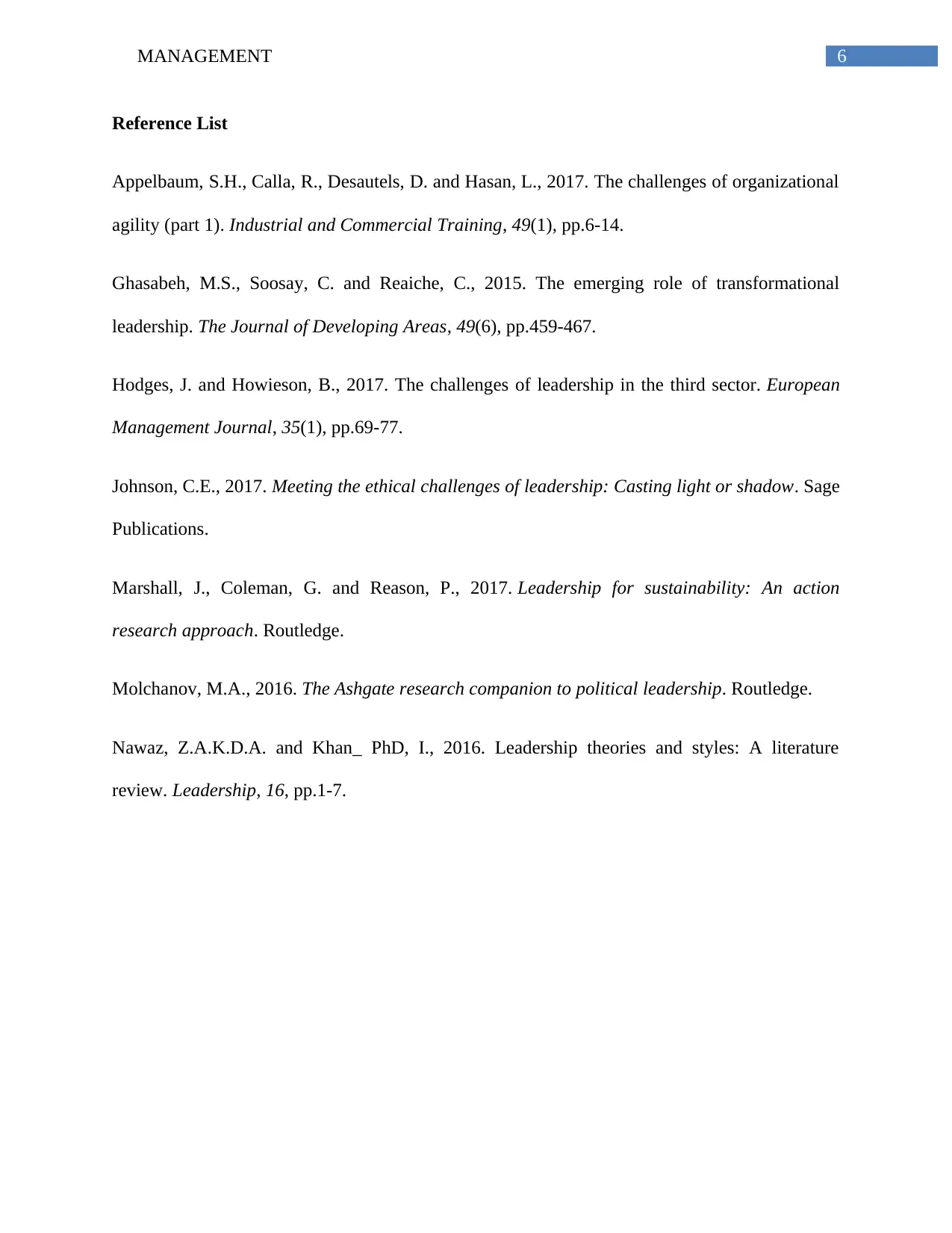
6MANAGEMENT
Reference List
Appelbaum, S.H., Calla, R., Desautels, D. and Hasan, L., 2017. The challenges of organizational
agility (part 1). Industrial and Commercial Training, 49(1), pp.6-14.
Ghasabeh, M.S., Soosay, C. and Reaiche, C., 2015. The emerging role of transformational
leadership. The Journal of Developing Areas, 49(6), pp.459-467.
Hodges, J. and Howieson, B., 2017. The challenges of leadership in the third sector. European
Management Journal, 35(1), pp.69-77.
Johnson, C.E., 2017. Meeting the ethical challenges of leadership: Casting light or shadow. Sage
Publications.
Marshall, J., Coleman, G. and Reason, P., 2017. Leadership for sustainability: An action
research approach. Routledge.
Molchanov, M.A., 2016. The Ashgate research companion to political leadership. Routledge.
Nawaz, Z.A.K.D.A. and Khan_ PhD, I., 2016. Leadership theories and styles: A literature
review. Leadership, 16, pp.1-7.
Reference List
Appelbaum, S.H., Calla, R., Desautels, D. and Hasan, L., 2017. The challenges of organizational
agility (part 1). Industrial and Commercial Training, 49(1), pp.6-14.
Ghasabeh, M.S., Soosay, C. and Reaiche, C., 2015. The emerging role of transformational
leadership. The Journal of Developing Areas, 49(6), pp.459-467.
Hodges, J. and Howieson, B., 2017. The challenges of leadership in the third sector. European
Management Journal, 35(1), pp.69-77.
Johnson, C.E., 2017. Meeting the ethical challenges of leadership: Casting light or shadow. Sage
Publications.
Marshall, J., Coleman, G. and Reason, P., 2017. Leadership for sustainability: An action
research approach. Routledge.
Molchanov, M.A., 2016. The Ashgate research companion to political leadership. Routledge.
Nawaz, Z.A.K.D.A. and Khan_ PhD, I., 2016. Leadership theories and styles: A literature
review. Leadership, 16, pp.1-7.
Paraphrase This Document
Need a fresh take? Get an instant paraphrase of this document with our AI Paraphraser
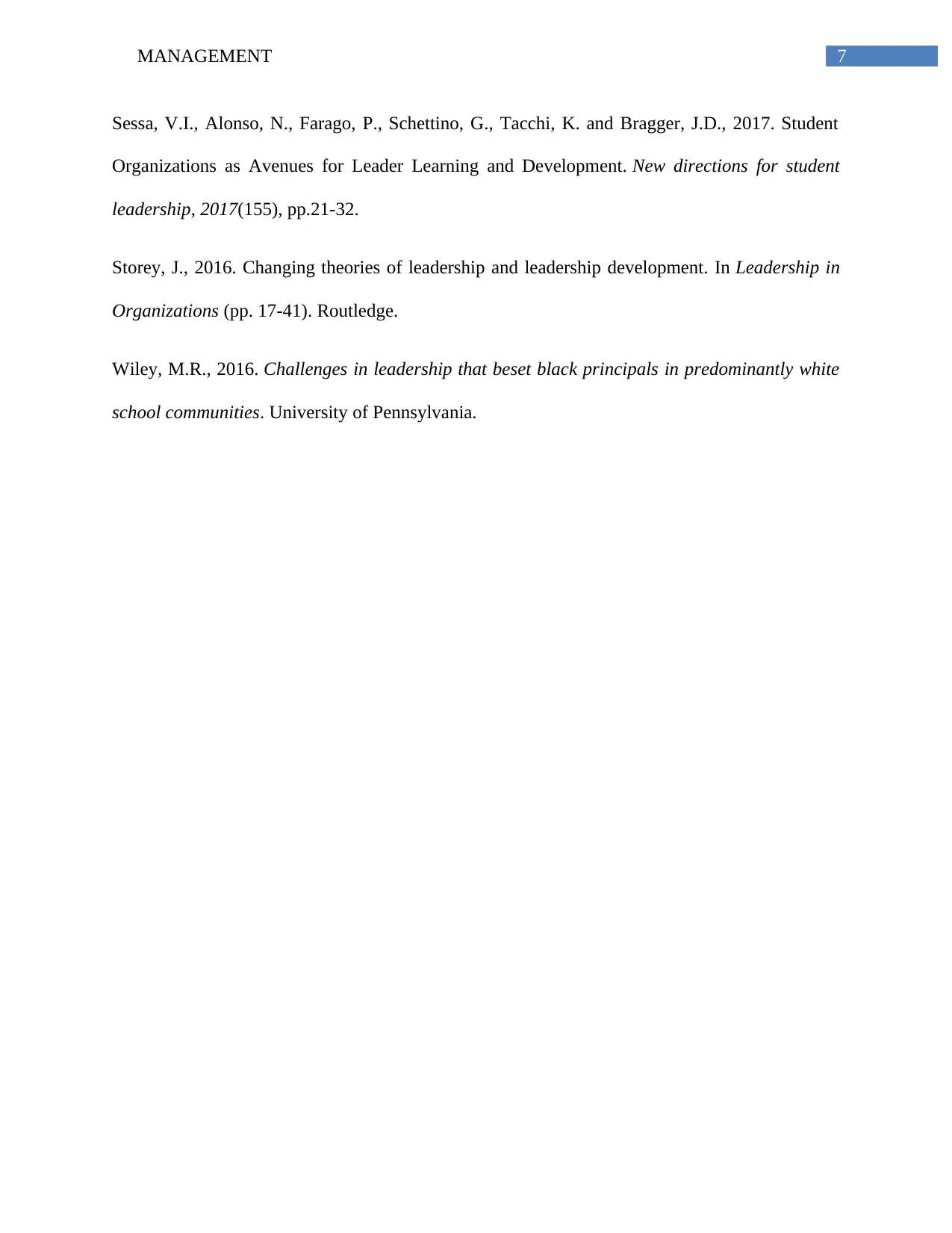
7MANAGEMENT
Sessa, V.I., Alonso, N., Farago, P., Schettino, G., Tacchi, K. and Bragger, J.D., 2017. Student
Organizations as Avenues for Leader Learning and Development. New directions for student
leadership, 2017(155), pp.21-32.
Storey, J., 2016. Changing theories of leadership and leadership development. In Leadership in
Organizations (pp. 17-41). Routledge.
Wiley, M.R., 2016. Challenges in leadership that beset black principals in predominantly white
school communities. University of Pennsylvania.
Sessa, V.I., Alonso, N., Farago, P., Schettino, G., Tacchi, K. and Bragger, J.D., 2017. Student
Organizations as Avenues for Leader Learning and Development. New directions for student
leadership, 2017(155), pp.21-32.
Storey, J., 2016. Changing theories of leadership and leadership development. In Leadership in
Organizations (pp. 17-41). Routledge.
Wiley, M.R., 2016. Challenges in leadership that beset black principals in predominantly white
school communities. University of Pennsylvania.
1 out of 8
Related Documents
Your All-in-One AI-Powered Toolkit for Academic Success.
+13062052269
info@desklib.com
Available 24*7 on WhatsApp / Email
![[object Object]](/_next/static/media/star-bottom.7253800d.svg)
Unlock your academic potential
Copyright © 2020–2025 A2Z Services. All Rights Reserved. Developed and managed by ZUCOL.





